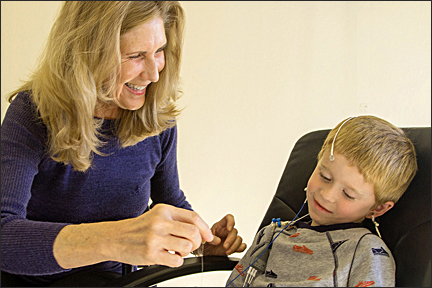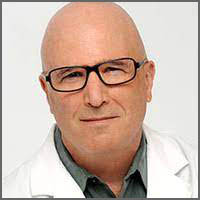Autistic Spectrum Disorders
Call for Information
(415) 326-5000
Children and adolescents have experienced successful treatment of Autistic Spectrum Disorders (ASD) with LENS Neurofeedback. This advanced alternative treatment supports the development of brain cells and healthy neural pathways for mental and physical functions.
“Neurofeedback participants showed significant improvements in sociability, communication, overall health, and sensory awareness compared with controls,” says David Dubin, MD. (see story below).
- LENS Neurofeedback treatments are medication- free and takes only a few minutes to complete a session.
- Shown effective in building healthy neurological brain networks.
- Noninvasive and passive treatments are ideal for children, teens or adults with autism.
Call a clinician at our Mill Valley, California location.
Treatment for Children, Adolescents, and Teens

Recent scientific developments in neurofeedback have profoundly improved the treatment of childhood mental and behavioral problems, including Autism and Asperger’s disorders. Instead of teaching parents coping strategies and behavioral containment techniques, therapists can now address dysfunctions by directly treating the brain. LENS neurofeedback combined with EchoNeuro treatment protocols engage the brain for optimal functioning without medications. Effective treatments for all ages are now available.
Neurofeedback Helps
Those with Autism

Research on autistic spectrum disorder (ASD) shows that neurofeedback (EEG biofeedback) can remediate anomalies in brain activation, leading to symptom reduction and functional improvement.
This evidence raises the hopes for a behavioral, psychophysiological intervention moderating the severity of ASD. Autism is a neurodevelopmental disorder characterized by a lack of appropriate eye contact, facial expression, social interaction, communication, and restricted repetitive behavior.
ASD represents a group of disorders, including Autism, PDD-nos, Rett’s Disorder, Child Disintegrative Disorder, and Asperger’s Disorder. The Centers for Disease Control and Prevention (2006) reported the prevalence of ASD as 2 to 6 per 1,000. Research has shown that related symptoms of ASD are the result of brain dysfunction in multiple brain regions. Functional neuroimaging and electroencephalography research have shown this to be related to abnormal neural connectivity problems. The brains of individuals with ASD show areas of both excessively high connectivity and deficient connectivity. In other words, some areas of the brain are chatting excessively with themselves while failing to communicate generally with other relevant regions.
In one 2006 study using connectivity-guided neurofeedback, pre-post analyses showed a 40 percent reduction in autistic symptoms, enhancement of function between the brain and behavior, and reduction of hyperconnectivity. Neurofeedback is capable of significantly remedying these anomalies and reducing autistic symptoms.
David Dubin, MD is an expert on Autism and Neurofeedback *published with permission by the author.
Emerging Brain-based
Interventions for Children
and Adolescents
Overview and Clinical Perspective by David Dubin, MD
Mainly based on word-of-mouth communication among parents of children with autistic spectrum disorder, there is rapidly growing clinical experience with EBF. In one published controlled group study of EBF for autism [33], 24 autistic participants were randomly assigned either to the EBF treatment or to a waitlist control group.
Twenty or more sessions (average, 36) of EBF using a standard protocol were given. Compared with controls, EBF participants showed significant improvements in measures of sociability, communication, health, and sensory awareness.
There is a strong consensus among EBF clinicians who work with ASD that EBF offers substantial benefits to a significant portion of this population. It seems to be helpful to more severe autistic individuals and those with high-functioning autism and Asperger’s disorder. Approximately 70% to 80% of patients with ASD benefit from the treatment. The degree of benefit ranges from mild to profound.
For example, one 4-year-old boy recently was diagnosed with pervasive developmental disorder not otherwise specified (NOS). He had severe behavioral and emotional self-regulation problems, with episodes of extreme aggression toward his brother and parents and self-injurious behavior, such as biting and head banging many times daily. He spoke in two- to three-word phrases, primarily echolalic, engaged in considerable repetitive behavior, and showed little social engagement, even with his mother.
After three months of twice-weekly EBF sessions, aggressive behavior and tantrums had subsided mainly, the language had improved markedly, and he began to engage in parallel and some joint pretend play with peers. His relationship with his parents and brother had improved markedly.
Generally, improvements are seen in attention and other aspects of executive function, anxiety, and emotional self-regulation, as well as the degree to which a child is tuned in to or engaged with the world around him rather than being “in his own world.” EBF treatment in ASD seems to require many more sessions than for other disorders; therefore, home training under the supervision of the clinician is sometimes used.
The rationale for the use of neurofeedback for ASD is similar to that for psychopharmacology. Virtually all children with ASD have significant attention deficits and impulsivity. Virtually all children with ASD also suffer from anxiety, obsessive-compulsive symptoms, and mood disturbances. EBF, like medications for ASD, is targeted at these areas of dysfunction.
David Dubin, MD, is an expert on Autism and Neurofeedback, published with permission by the author.
“Covert” Neurofeedback
Tunes-up the Social
Brain in ASD
Real-time fMRI-based neurofeedback is a relatively young field with the potential to impact the currently available treatments of various disorders.
Various types of neurofeedback continue to influence cognitive functioning with increased communications between two critical networks of the social brain in ASD.
